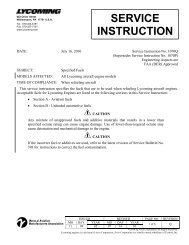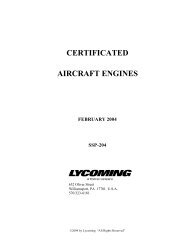You also want an ePaper? Increase the reach of your titles
YUMPU automatically turns print PDFs into web optimized ePapers that Google loves.
detonation at high power output because combustion temperature<br />
and pressure are, of course, higher than they are at low or medium<br />
powers. Leaning the mixture at high power can cause it.<br />
Unless detonation is heavy, there is no cockpit evidence of its<br />
presence. Light to medium detonation may not cause noticeable<br />
roughness, observable cylinder head or oil temperature increase,<br />
or loss of power. However, when an engine has experienced<br />
detonation, we see evidence of it at teardown as indicated by<br />
dished piston heads, collapsed valve heads, broken ring lands<br />
or eroded portions of valves, pistons and cylinder heads. Severe<br />
detonation can cause a rough-running engine and high cylinder<br />
head temperature.<br />
D e t o n a t i o n a n d P r e i g n i -<br />
t i o n<br />
PREIGNITION<br />
Preignition, as the name implies, means that combustion takes<br />
place within the cylinder before the timed spark jumps across<br />
the spark plug terminals. This condition can often be traced to<br />
excessive combustion deposits or other deposits (such as lead)<br />
which cause local hot spots. Detonation often leads to preignition.<br />
However, preignition may also be caused by high power<br />
operation at excessively leaned mixtures. Preignition is usually<br />
indicated in the cockpit by engine roughness, backfiring, and<br />
by a sudden increase in cylinder head temperature. It may also<br />
be caused by a cracked valve or piston, or a broken spark plug<br />
insulator which creates a hot point and serves as a glow spot.<br />
Specifically, preignition is a condition similar to early timing of<br />
the spark. Preignition is a serious condition in the combustion<br />
chamber and will cause burnt pistons and tuliped intake valves.<br />
The best temporary in-flight methods for correcting preignition<br />
and detonation are to reduce the cylinder temperature by retarding<br />
the throttle, enriching the mixture, opening cowl flaps if available,<br />
or a combination of all of these.<br />
<strong>Lycoming</strong> Engineering, in their continuing effort to improve our<br />
engines, developed a better method of manufacturing hardened<br />
alloy steel cylinder barrels a number of years ago by means<br />
of a method known as nitriding. Simply described, the addition<br />
of nitrogen to the surface of an alloy steel produced a hard, wearresistant<br />
surface. Commercially, the introduction of nitrogen into<br />
the surface layers of alloy steel is brought about by subjecting<br />
the practically finished parts to an atmosphere of ammonia gas.<br />
The process requires special heat treating furnaces which are<br />
air tight and capable of holding the parts at a high temperature.<br />
At this heat level (975 o F), the ammonia gas flowing into the<br />
furnace is broken down into its elements of hydrogen and<br />
nitrogen, and this is the source of the nitrogen which penetrates<br />
the surfaces of the steel. In order to produce a satisfactory<br />
nitrided surface, the process must be operated for an extended<br />
period of time, generally from 25 to 80 hours. Along with<br />
cylinder barrels, <strong>Lycoming</strong> nitrides all its crankshafts and<br />
some gears.<br />
The nitriding process applied to cylinder barrels has been thoroughly<br />
service tested in military as well as commercial service.<br />
0 L y c o m i n g F l y e r<br />
After having been FAA type tested, we began production of<br />
engines using nitrided cylinders in 1960. The service record of<br />
these cylinders has been excellent. In fact, our management was<br />
so impressed with the favorable service record of the nitrided<br />
cylinder that they changed from chrome to nitrided cylinders<br />
in all our higher powered turbocharged and supercharged<br />
engines. Some favorable characteristics of nitrided barrels are<br />
as follows:<br />
1. Reduced cylinder wall wear - the harder a surface the more<br />
difficult to wear down.<br />
2. Natural choked barrels provide improved piston ring life due to<br />
a resulting straight cylinder wall when engine is hot or operating,<br />
and a better job of sealing.<br />
3. Nitriding permits use of chrome plated piston rings, which are<br />
more wear resistant and quite compatible with hardened steel.<br />
4. Nitriding provides a hardened surface with an increased<br />
fatigue strength.<br />
5. It also has the ability to resist softening when excessively heated<br />
during engine operation.<br />
These worthwhile features in the power plants have meant even<br />
longer operating life than standard steel barrels, and they mean<br />
dependability and economy.<br />
Now chrome plated cylinders cannot be obtained from the factory,<br />
but the identification specification for them has been an orange<br />
band around the cylinder base, or the equivalent color on the<br />
edges of the top cylinder head fins between the two valve push<br />
rod shroud tubes. The color coding for the nitrided cylinders is<br />
azure blue and will appear in either of the two locations indicated<br />
above. The band around the cylinder base is used when cylinders<br />
are painted black as a separate operation prior to engine assembly.<br />
The color coding on the top edges of the cylinder head fins has<br />
been used on engines painted all gray after assembly.<br />
From the service standpoint on nitrided cylinders, there<br />
are three methods of handling an engine at overhaul.<br />
1. The barrels can simply be reworked and returned to<br />
service if they are not beyond service limits.<br />
2. The barrel can be reground and then chrome plated, but<br />
the factory has achieved better results with nitriding and<br />
uses method three.<br />
3. The old cylinder may be discarded and replaced with<br />
a new one as in the <strong>Lycoming</strong> factory overhaul and<br />
rebuild programs.<br />
CHROME VS. NITRIDING<br />
Either method provides a satisfactory hard-wearing surface, but<br />
application of the chrome plate is a critical operation. Engines<br />
with chrome or nitride-hardened barrels have a good wear characteristic,<br />
and are more rugged than standard steel barrels. In spite<br />
of hardened barrels, a good, properly maintained air filter is still<br />
a must. Pistons are moving up and down at a rate of more than<br />
two thousand times per minute, and when dirt or any abrasive<br />
is introduced into the combustion chambers, it causes a lapping<br />
process which rapidly wears metal away. No engine can digest<br />
dirt and give a satisfactory service life.







